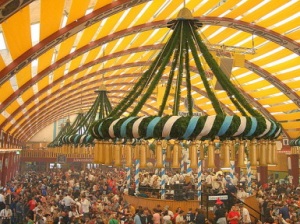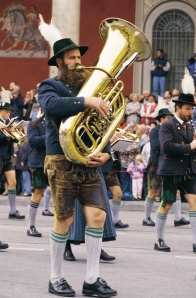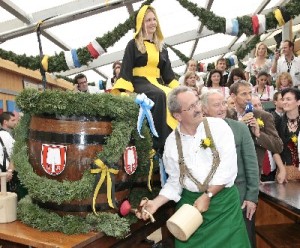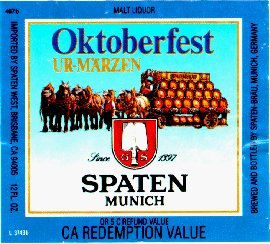Boasting an attendance of more than six million people every year, Munich’s Oktoberfest is officially the world’s biggest party.
While several other cities across the world also hold Oktoberfest celebrations, modeled after the Munich event and held on similar dates, none rival the authenticity and grand scale of the original. Unfortunately, the closest I have ever come to Oktoberfest is drinking Oktoberfest bier and polka dancing at local Oktoberfest festivals in the United States. Needless to say, that just doesn’t cut it. Alas, I will be forced to celebrate Oktoberfest state-side until circumstances finally allow me to travel to Germany for the real festival.
Surprisingly, most people know very little about Oktoberfest — except that it is a massive festival that spans across 16 (sometimes 17) days – consisting of excessive beer & German food consumption and lots of debauchery.
This past Saturday, (September 17th) marked the official start of the 178th Oktoberfest. Store shelves and bars across the country have been well-stocked stocked with various Oktoberfest biers, and today is the perfect day to talk about the history of the world’s largest party.
According to legend and lore, Oktoberfest is the result of an extended wedding reception that followed the marriage of Crown Prince Ludwig of Balvaria and Princess Therese of Saxony-Hildburghausen on October 12, 1810. Both were later to become King & Queen of Bavaria.
The citizens of Munich were invited to attend the post-wedding festivities, which lasted several days and concluded with a great horse race. The decision to repeat the horse races in the subsequent year gave rise to the tradition of the Oktoberfest.
The first Agricultural Show, designed to boost Bavarian agriculture, was included in with the horse racing festivities in 1811. In the year 1812, Oktoberfest was canceled as a result of Bavaria’s was involvement in the Napoleonic war.
Carnival booths were introduced in 1816, with prizes mostly consisting of silver, porcelain and jewelry. And in 1918, the first carousel and two swings were included into the event.
The founding citizens of Munich assumed responsibility over festival management in 1819 and it was agreed that the Oktoberfest festival would be celebrated each and every year without exception.
INTERESTING FACT: Since its beginnings the Oktoberfest has been canceled 24 times due to war, disease and other emergencies.
The first Oktoberfest parade, honoring the marriage of King Ludwig I and Therese of Bavaria, took place in 1835. Since 1850, the parade has become a yearly event and an important component of Oktoberfest. Each year some 8,000 people, mostly from Bavaria & dressed in traditional costumes walk through the center of Munich to the Oktoberfest.
The year 1850 also marks the first appearance of the Statue of Bavaria, commissioned by Ludwig I of Bavaria and constructed by Johann Baptist Stiglmaier and Ferdinand von Miller. The Bavaria statue is a bronze-cast statue of a female figure representing Bavaria’s “secular patron saint.” She is located at the border of the Theresienwiese in Munich, Bavaria, Germany – where Oktoberfest takes place each year.
Thirst was originally quenched at beer stands, which eventually turned into beer tents in 1896. The beer tents and halls were originally set up by enterprising landlords with backing from local breweries and have been a main staple of the event ever since.
Since 1950, there has been a traditional festival opening consisting of a twelve gun salute and the tapping of the first keg of Oktoberfest beer at noon by the Lord Mayor of Munich with the cry “O’zapft is!” (which literally translates to “It’s tapped!” in the Austro-Bavarian dialect). This event is held the first Saturday of each Oktoberfest in one of the enormous beer tents. Once the barrel is tapped, all visitors are then allowed to quench their thirst and the massive party officially begins!
The year 1960 marked the end of the horse races. By that time, Oktoberfest had already turned into an enormous world-famous festival and has since grown to become the largest folk fest in the world.
Oktoberfestbiers have been served at Oktoberfest since 1818 and are supplied by 6 breweries known as the “Big Six.” These include Spaten, Lowenbrau, Augustiner, Hofbrau, Paulaner and Hacker-Pschorr.
Originally, Oktoberfestbiers were traditional German pale lagers called Märzen. They were brewed in March and allowed to ferment slowly during the summer months. They typically run at about 5 to 6% abv. Technically, authentic Oktoberfestbier is brewed only by the breweries within the city limits of Munich. Today, the terms Oktoberfest and Märzen are used by non-Oktoberfest brewers in Germany and the USA to market pale lagers of this strength.
THE GERMAN BEER INSTITUTE has an excellent article about this history Oktoberfestbier HERE.
I will be honest. Lagers do not particularly excite me. In fact, I tend to avoid that style of beer as much as possible. HOWEVER, I am predisposed to having a preference to Spaten – over all the other Oktoberfestbeirs.
Is it possible to have such a predisposition? YES. My father is a marketers dream. He is the king of brand preference and brand loyalty. When he finds something he likes, he becomes an obssesed man. And this is how he is with Spaten.
It did not matter where he goes and how much beer is already being provided, my father ALWAYS brings his own beer – and it is ALWAYS Spaten. At any given time, the refrigerator in his garage is loaded with Spaten. For my 21st birthday my dad picked out the keg. And guess what he chose? Yep, that’s right … SPATEN!
Make sure to properly celebrate the season with a pint, liter, or boot of Oktoberfestbier!
CHEERS!




























